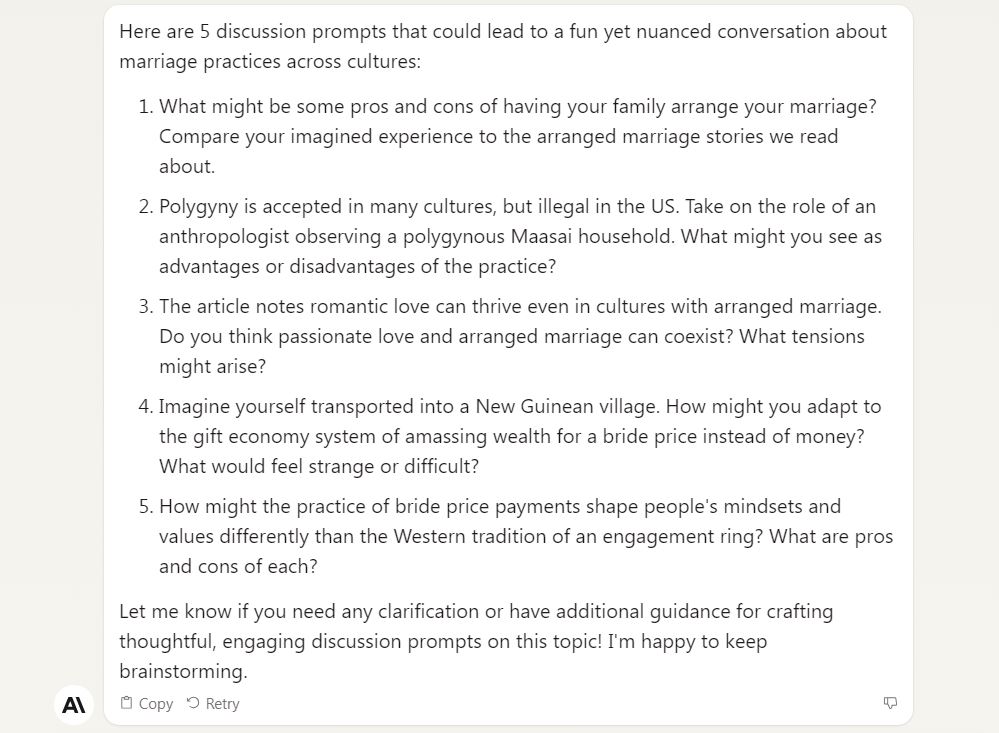EJ Sobo recently published an article with the provocative title, “Could ChatGPT Propmpt a New Golden Age in Higher Education?” While many of us were watching the very foundation of our courses (take-home essays, exams, etc.) crumbling away with the advent of Chat-GPT, Sobo reminded us that moments like this offer the opportunity to re-invnet our teaching in ways that might better match up with our core pedagogical values.
Today I teamed up with EJ to discuss practical ways that we can improve our teaching in an AI-World. If you are a member of the American Anthropological Association, you can view the full video here.
Top Tip: Use AI in your own research process and let your experience inform your teaching.
AI is a powerful research tool, useful for many different phases of research. I use it to:
- Learn languages for fieldwork
- Simulate fieldwork conversations, improving my language skills in specific domains
- Summarize research articles (expanding my knowledge of new literature more quickly)
- Translate old Chinese texts (that I cannot read otherwise)
- Brainstorm connections between articles and ideas
- Try out different theoretical perspectives on specific research data
- Create “.5th” Drafts (they don’t really qualify as first drafts, but they get creativity flowing)
- Create illustrations of heavens and Buddhas that are unique to my fieldwork, and have never been drawn or pictured before (or only rarely)
Some of these might surprise you, espeically if you have only used the free Chat-GPT 3.5. For most of the above I us Claude, which allows me to upload full articles or even books to analyze and disuss. Let’s look at some of the differences between AI generators.
The AI Landscape
| AI | How it works | Input Tokens | Hallucination Risk | Advantages |
| Claude | “Constitutional AI” (not trained) built on limited dataset including academic works and encyclopedias | 100,000 (175 pages) | Low | Relatively Truthful. Can read a whole chapter, article, or small book and summarize it, etc. |
| Chat-GPT | Large Language Model, 175 billion parameters. | 8,000 (6,000 words) | Moderate | Larger dataset. Paid version includes image generator, audio conversations and more. |
| Bard | Even Larger Language Model | Unknown but maybe only 1,000 (750 words) | High due to large size, also uses poor sources sometimes. | Largest dataset |
The Perfect Prompt
Specific Request + Context + Intention + Format
| S + C + I + F | Example |
| Specific Request: Think about both the boundary and the territory. Creat limits as well as defined territory. | Create a list of key terms and definitions from this attached article. Do not include … |
| Context: Who is this for? Where are they? What are they doing? | This is for students at a large university in a large introduction to anthropology class in Kansas. Most of them are 18 to 20 years old. |
| Intent: What is your goal? | I want them to learn I want them to understand _______, I want them to think critically about ______, I want them to develop ______ skills. |
| Output: Tables are often very useful. Also consider numbered lists, Top 10s, or specific generes like stories, scripts, dialogues, etc. | Organize this in a table with 2 columns, one for the key term and the other for the definition. |
Additional Power-Ups
Tone: Ask for the response to be formal, witty, conversational, poetic, professional, or any other tone or style you can imagine.
Add examples: Research on AI has shown that examples improve outputs dramatically.
Powerful Follow-Ups
Are you sure? Research has shown that AI models are good at interrogating their own answers and spotting their mistakes. A prompt as simple as “Are you sure?” can deliver great results. For better results, ask about specific ideas, or bring up any counter ideas or other important facts it has left out.
Continue where you left off. AI will often stop before it is actually out of ideas. If you like where things are going, just ask it to continue.
Fore more, check out Learn Prompting
Low-Hanging Fruit: Creating Class Resources
Here are 7 examples of class resources that can be generated quickly using AI.
| Idea | Prompt Example |
| Warm-up activities | What is an activity or prompt that would get students thinking about their own cultural assumptions regarding love and marriage? |
| Review questions | Can you provide 5 multiple choice questions reviewing key concepts from the reading like gift economies, dowries, polygamy, etc.? |
| Deep-thinking questions | What are 3 thoughtful reflection questions about the role of cultural values in shaping ideas about love and marriage? |
| Discussion questions | Can you give 5 discussion prompts that could lead to a fun but deep and nuanced conversation comparing marriage practices across cultures? |
| Review sheets | Can you create a 1-page review handout of key terms from the reading like … |
| Assignment ideas | Give me 3 applied project ideas related to ethnographic methods that build on the concepts in the reading. |
| Exam questions | Can you provide 5 potential short answer exam questions assessing students’ understanding of how infrastructure, social structure, and superstructure interact to shape ideas of love and marriage? |
Remember to combine these with Context, Intent, and Output.
| Specific Request | Can you give 5 discussion prompts that could lead to a fun but deep and nuanced conversation comparing marriage practices across cultures? Use the attached chapter for guidance. (I attached Love in Four Cultures from my textbook.) |
| Context | This is for students at a large university in a large introduction to anthropology class in Kansas. Most of them are 18 to 20 years old. They will be meeting in groups of 10. They have a wide range of sexualities and life goals. |
| Intent | I want them to see new ways of thinking about love by looking at other cultures and think deeply about the human condition and what love means to us as humans. |
| Output | (In this case I will not define the output.) |

“AI-Proof” Assessments and Activities
Start from a place of Trust: This is an incredible time to be alive as a learner. We can all benefit tremendously by using AI tools. Our primary job is not to enforce rules or manage cheating. If we do that, our class can devolve into a “game” in which students are trying to “get by” and we are placed in the role of the gate-keeper guarding the credits and grades. By starting from a place of trust we can orient ourselve to the joy of learning in this most remarkable moment when we have been given access to these incredible tools.
But we all still recognize the importance of writing as a deep process of thinking and organizing our thoughts, and it feels like Chat-GPT might be taking that away from us. Here are a few tips to preserve writing as a core activity.
Prioritize Process: EJ makes several good suggestions in her paper:
- Self-Reflection: Ask students to keep self-reflection journals throughout the writing process and use these for assessment, or weigh them more heavily than the work itself
- Chunk it up: into outlines, drafts, and multiple revisions. Or have them build the paper throughout the semester with smaller assignments like lit reviews, methods, analysis, etc.
- Peer Reviews: throughout the writing process
Experiential Out-in-the-World Assignments
- ANTH101.com Challenges: There are several examples right here on this website, as this textbook is oriented toward “challenges” that get students out into the world talking to strangers, seeing the strange in the familiar, and trying new things (to name a few).
- Live Presentations
“AI-Adjacent” Assessments and Activities
Most (All?) of our students will be using AI in their careers and everyday lives, and it will only become more essential in the coming years. So while AI-Proof Assignments can be useful and necessary, we also need to embrace AI and start building assignments that encourage the use of AI in effective ways.
Here we return to the top tip from above:
Use AI in your own research process and let your experience inform your teaching.
- Here are 3 assignment ideas I have developed since integrating AI into my research process.
Asking Bigger Questions: AI can quickly answer simple questions, making such questions obsolete as part of take-home assignments. But AI also allows students to engage with much bigger questions in productive ways that can produce a high level of learning and spark curiosity. For example, last year (before AI), I asked my students to compare and contrast multiple political economy systems (multiple varieties of communism, capitalism, anarchism, authoritarianism, and every mixture thereof). I provided a broad overview of the most common systems that have been tried or imagined over the past 100 years and asked them to create their own utopian system based on their values and priorities. This is obviously a very big question, and for most students, it was just overwhelming because they just didn’t feel like they knew enough about all of the different systems and possibilities. This year, I encouraged the use of AI to help them, and asked them to turn in not only their Utopia, but also the key moments in their AI conversations that led them to their conclusions. Students reported learning new terms and encountering new ideas they had never considered, but even more rewarding for me was hearing about how this process led students into fascinating deep dives into their own interests and how they intersect with big problems. For example, an architecture student was able to use her domain-specific knowledge to do a deep dive with Claude into how the Gifu Kitagaga Apartments by Sejima (a public housing project in Japan) might play a role in her Utopia.
Requiring a lot more Reading: Instead of worrying about students using AI to get quick summaries of an article, assign 20 articles and encourage your students to use AI to “read” them. They can start by asking Claude for a summary, but then they can ask follow-up questions based on their own interests. This does not replace careful reading of a single text, but has its own positive outcomes: They can see a larger scope of different perspectives, they can see the larger scholarly conversation more clearly, and they can feel empowered to explore literature that might have seemed too difficult without AI assistance.
Interrogate multiple texts from different theoretical angles: One of the nice things about Claude is that it will read everything in the conversation each time it responds. This means that you can keep adding multiple articles into the conversation and then ask Claude to explore the texts for various ways they intersect with each other. Claude is also well-versed in different theoretical perspectives, and can be prompted to provide analysis from different perspectives on the text.
Building AI-Literacy
As with any new technology that starts to permeate our lives, it is important for all of us to build more AI-Literacy and to help our students in this regard as well. There are two ways to build this literacy, both of which are important
Critical Approaches: to build Critical Awareness of the Limitations, Biases, and Potential Negative Impacts of AI
- Invite students to analyze and edit a short essay written by AI. (EJ has a great story about this)
- Compare blindly authored works, with one or two by AI
- Collectively interrogate AI responses for bias and limitations as a class
Pragmatic Approaches: to build skills for leveraging AI
- Show students how to use AI to improve their own learning by doing some of the same practices listed on this page, everything from the “low-hanging fruit” of creating their own review materials to exploring really big questions
- Show students how you are using AI in your research and how they might use it as well
- Invite students to do fun things using AI (cooking, learning languages, coming up with new jokes) so they can “play” their way toward more literacy, noting the potentials and pitfalls of the technology as they go
More References from EJ:
ChatGPT as a teaching tool, not a cheating tool
- https://www.timeshighereducation.com/campus/chatgpt-teaching-tool-not-cheating-tool
- https://www.bbc.co.uk/news/resources/idt-74697280-e684-43c5-a782-29e9d11fecf3
- The Wharton School at the University of Pennsylvania offers their entire five-part, hour-ish long ‘Interactive Crash Course: Practical AI for Instructors’ free on YouTube: https://www.youtube.com/playlist?list=PLwRdpYzPkkn302_rL5RrXvQE8j0jLP02j
- https://www.christopherspenn.com/2023/07/almost-timely-news-july-2-2023-getting-started-with-generative-ai-101/?utm_source=almost-timely-newsletter&utm_medium=email&utm_campaign=almost-timely-newsletter-2023-07-02
- Could ChatGPT Prompt a New Golden Age in Higher Education?
- AI in the Classroom: Faculty Futures Podcast (Soundcloud; Apple Podcasts)
- The Pedagogical Dangers of AI Detectors for the Teaching of Writing
- Responsible Usage
- https://docs.google.com/document/d/1gCzfFkds2gaHolo9zN2OuE7mqRjfPN2Gvg4IA5Rz8Nc/edit
- https://docs.google.com/document/d/1AUqngISbd9Ve9m6F5qMgmKh1UH5MT_8w99VlpmxmtjI/mobilebasic?fbclid=IwAR3eXgZUFTIAmgMV229STioq_KIFB42XHd6QgQuyi1IXc4Tr4kiOP2ZWWDc_aem_AWnQcsH_lqNAx2ryK2DXxdeFYTY9-ZHrKnEcBfHP5sfP4INGsArOhgBbxHenODsQghw
- https://www.washingtonpost.com/technology/interactive/2023/how-to-talk-ai-chatbot-chatgpt/
- https://learnprompting.org/docs/intro
- https://its.sdsu.edu/ai





